路面设计外文翻译---柔性路面设计
- 格式:docx
- 大小:28.70 KB
- 文档页数:10
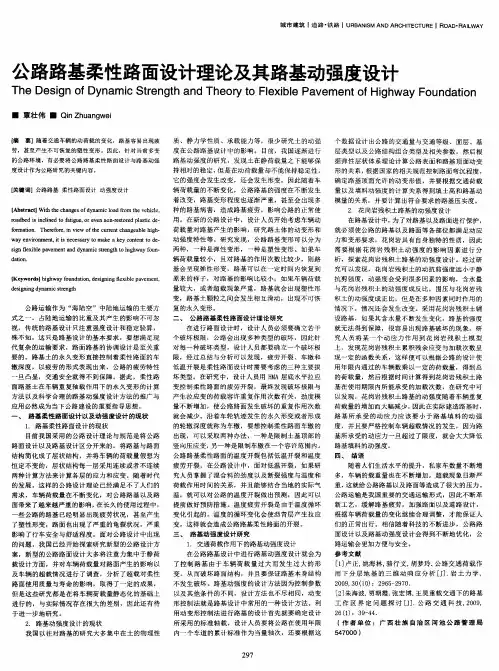
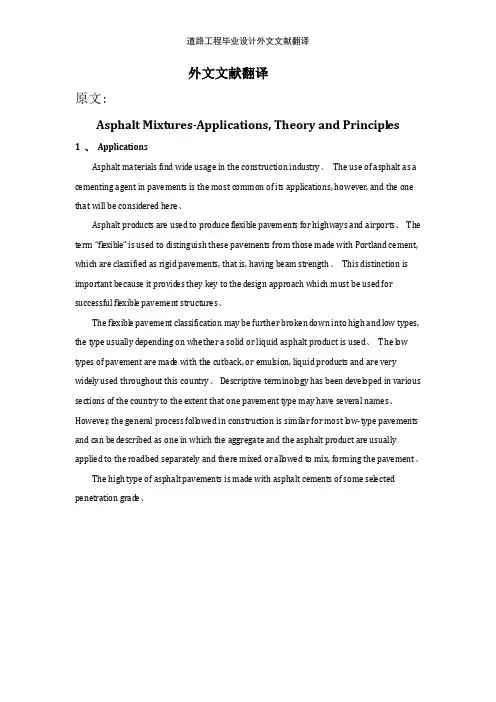
外文文献翻译原文:Asphalt Mixtures-Applications, Theory and Principles1 、ApplicationsAsphalt materials find wide usage in the construction industry、The use of asphalt as a cementing agent in pavements is the most common of its applications, however, and the one that will be consid ered here、Asphalt products are used to produce flexibl e pavements for highways and airports、The term “fl exible” is used to distinguish these pavements from those made with Portland cement, which are classified as rigid pavements, that is, having beam strength、This distinction is important because it provid es they key to the design approach which must be used for successful flexibl e pavement structures、The flexibl e pavement classification may be further broken d own into high and l ow types, the type usually depending on whether a solid or liquid asphalt product is used、The l ow types of pavement are mad e with the cutback, or emulsion, liquid products and are very widely used throughout this country、Descriptive terminol ogy has been developed in various sections of the country to the extent that one pavement type may have several names、However, the general process foll owed in construction is similar for most l ow-type pavements and can be described as one in which the aggregate and the asphalt product are usually applied to the roadbed separately and there mixed or all owed to mix, forming the pavement、The high type of asphalt pavements is made with asphalt cements of some sel ected penetration grad e、Fig、·1 A modern asphalt concrete highway、Shoul der striping is used as a safely feature、Fig、·2 Asphalt concrete at the San Francisco International Airport、They are used when high wheel l oads and high volumes of traffic occur and are, therefore, often designed for a particular installation、2 、Theory of asphalt concrete mix designHigh types of flexible pavement are constructed by combining an asphalt cement, often in the penetration grad e of 85 to 100, with aggregates that are usually divided into three groups, based on size、The three groups are coarse aggregates, fine aggregates, and mineral filler、These will be discussed in d etail in later chapter、Each of the constituent parts mentioned has a particular function in the asphalt mixture, and mix proportioning or d esign is the process of ensuring that no function is negl ected、Before these individual functions are examined, however, the criteria for pavement success and failure should be consid ered so that d esign objectives can be established、A successful fl exible pavement must have several particular properties、First, it must be stable, that is to resistant to permanent displacement under l oad、Deformation of an asphaltpavement can occur in three ways, two unsatisfactory and one desirable、Plastic deformation of a pavement failure and which is to be avoid ed if possible、Compressive deformation of the pavement results in a dimensional change in the pavement, and with this change come a l oss of resiliency and usually a d egree of roughness、This d eformation is less serious than the one just described, but it, too, leads to pavement failure、The desirable type of deformation is an elastic one, which actually is beneficial to flexibl e pavements and is necessary to their long life、The pavement should be durable and should offer protection to the subgrade、Asphalt cement is not impervious to the effects of weathering, and so the design must minimize weather susceptibility、A durable pavement that d oes not crack or ravel will probably also protect the roadbed、It must be remembered that flexible pavements transmit loads to the subgrad e without significant bridging action, and so a dry firm base is absolutely essential、Rapidly moving vehicl es d epend on the tire-pavement friction factor for control and safety、The texture of the pavement surfaces must be such that an adequate skid resistance is developed or unsafe conditions result、The design procedure shoul d be used to select the asphalt material and aggregates combination which provid es a skid resistant roadway、Design procedures which yield paving mixtures embodying all these properties are not available、Sound pavements are constructed where materials and methods are selected by using time-tested tests and specifications and engineering judgments al ong with a so-call ed design method、The final requirement for any pavement is one of economy、Economy, again, cannot be measured directly, since true economy only begins with construction cost and is not fully determinable until the full useful life of the pavement has been record ed、If, however, the requirements for a stable, durable, and safe pavement are met with a reasonable safety factor, then the best interests of economy have probably been served as well、With these requirements in mind, the functions of the constituent parts can be examined with consideration give to how each part contributes to now-established objectives or requirements、The functions of the aggregates is to carry the load imposed on the pavement, and this is accomplished by frictional resistance and interl ocking between the individual pieces of aggregates、The carrying capacity of the asphalt pavement is, then, related to thesurface texture (particularly that of the fine aggregate) and the density, or “compactness,”, of the aggregates、Surface texture varies with different aggregates, and while a rough surface texture is desired, this may not be available in some l ocalities、Dense mixtures are obtained by using aggregates that are either naturally or artificially “well graded”、This means that the fine aggregate serves to fill the voids in the coarser aggregates、In addition to affecting density and therefore strength characteristics, the grading also influences workability、When an excess of coarse aggregate is used, the mix becomes harsh and hard to work、When an excess of mineral filler is used, the mixes become gummy and difficult to manage、The asphalt cement in the fl exibl e pavement is used to bind the aggregate particl es together and to waterproof the pavements、Obtaining the proper asphalt content is extremely important and bears a significant influence on all the items marking a successful pavement、A chief objective of all the design methods which have been devel oped is to arrive at the best asphalt content for a particular combination of aggregates、3 、Mix design principl esCertain fundamental principles underlie the design procedures that have been developed、Before these procedures can be properly studied or applied, some consid eration of these principles is necessary、Asphalt pavements are composed of aggregates, asphalt cement, and voids、Considering the aggregate alone, all the space between particles is void space、The volume of aggregate voids depends on grading and can vary widely、When the asphalt cement is add ed, a portion of these aggregate voids is filled and a final air-void volume is retained、The retention of this air-void volume is very important to the characteristics of the mixture、The term air-void volume is used, since these voids are weightless and are usually expressed as a percentage of the total volume of the compacted mixture、An asphalt pavement carries the applied load by particl e friction and interlock、If the particl es are pushed apart for any reason , then the pavement stability is d estroyed、This factor indicates that certainly no more asphalt shoul d be ad ded than the aggregate voids can readily hold、However ,asphalt cement is susceptibl e to volume change and the pavement is subject to further compaction under use、If the pavement has no air voids when placed, or if it loses them under traffic, then the expanding asphalt will overfl ow in a condition known asbleeding、The l oss of asphalt cement through bleeding weakens the pavement and also reduces surface friction, making the roadway hazard ous、Fig、·3 Cross section of an asphalt concrete pavement showing the aggregate framework bound together by asphalt cement、The need for a minimum air-void volume (usually 2 or 3 per cent ) has been established、In addition, a maximum air-void volume of 5 to 7 per cent shoul d not be exceed、An excess of air voids promotes raveling of the pavement and also permits water to enter and speed up the deteriorating processes、Also, in the presence of excess air the asphalt cement hardens and ages with an accompanying loss of durability and resiliency、The air-void volume of the mix is determined by the d egree of compaction as well as by the asphalt content、For a given asphalt content, a lightly compacted mix will have a large voids volume and a l ower d ensity and a greater strength will result、In the laboratory, the compaction is controlled by using a specified hammer and regulating the number of bl ows and the energy per blow、In the field, the compaction and the air voids are more difficult to control and tests must be made no specimens taken from the compacted pavement to cheek on the d egree of compaction being obtained、Traffic further compact the pavement, and all owance must be mad e for this in the design、A systematic checking of the pavement over an extended period is need ed to given factual information for a particular mix、A change in density of several per cent is not unusual, however、Asphalt content has been discussed in connection with various facets of the ix design problem、It is a very important factor in the mix design and has a bearing an all the characteristics ld a successful pavement: stability, skid resistance, durability, and economy、As has been mentioned, the various d esign procedures are intended to provide a means for selecting the asphalt content 、These tests will be considered in detail in a future chapter ,but the relationship between asphalt content and the measurable properties of stability, unit weight, and air voids will be discussed here、Fig、4 Variations in stability, unit weight, and air-void content with asphalt cement content、If the gradation and type of aggregate, the degree of compaction, and the type of asphalt cement are controll ed, then the strength varies in a predictable manner、The strength will increase up to some optimum asphalt content and then decrease with further additions、The pattern of strength variation will be different when the other mix factors are changed, and so only a typical pattern can be predicted prior to actual testing、Unit weight varies in the same manner as strength when all other variabl e arecontroll ed、It will reach some peak value at an asphalt content near that determined from the strength curve and then fall off with further additions、As already mentioned, the air-void volume will vary with asphalt content、However, the manner of variation is different in that increased asphalt content will d ecrease air-void volume to some minimum value which is approached asymptotically、With still greater additions of asphalt material the particles of aggregate are only pushed apart and no change occurs in air-void volume、In summary, certain principles involving aggregate gradation, air-void volume, asphalt content, and compaction mist be understood before proceeding to actual mix d esign、The proper design based on these principl es will result in sound pavements、If these principles are overlooked, the pavement may fail by one or more of the recognized modes of failure: shoving, rutting, corrugating, becoming slick when the max is too ‘rich’; raveling, cracking,having low durability when t he mix is too ‘l ean’、It should be again emphasized that the strength of flexible is, more accurately, a stability and d oes not indicate any ability to bridge weak points in the subgrade by beam strength、No asphalt mixture can be successful unless it rests on top of a properly designed and constructed base structure、This fact, that the surface is no better than the base, must be continually in the minds of those concerned with any aspect of fl exible pavement work、译文:沥青混合料的应用、理论与原则1、应用沥青材料如今在建筑行业广泛使用。
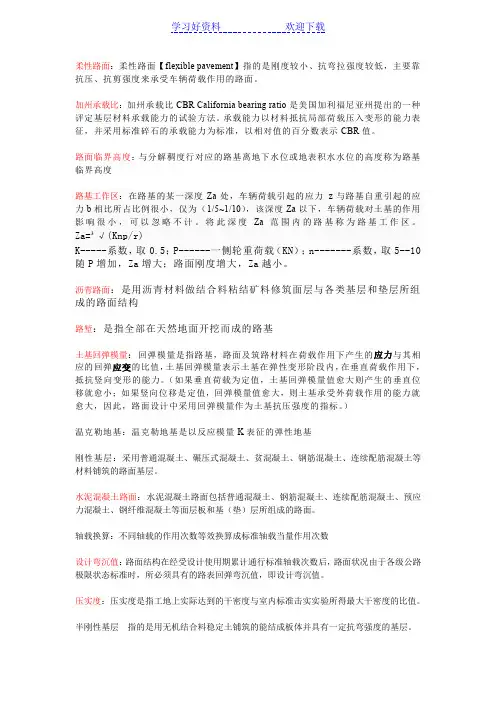
柔性路面:柔性路面【flexible pavement】指的是刚度较小、抗弯拉强度较低,主要靠抗压、抗剪强度来承受车辆荷载作用的路面。
加州承载比:加州承载比CBR California bearing ratio是美国加利福尼亚州提出的一种评定基层材料承载能力的试验方法。
承载能力以材料抵抗局部荷载压入变形的能力表征,并采用标准碎石的承载能力为标准,以相对值的百分数表示CBR值。
路面临界高度:与分解稠度行对应的路基离地下水位或地表积水水位的高度称为路基临界高度路基工作区:在路基的某一深度Za处,车辆荷载引起的应力z与路基自重引起的应力b相比所占比例很小,仅为(1/5~1/10),该深度Za以下,车辆荷载对土基的作用影响很小,可以忽略不计。
将此深度Za范围内的路基称为路基工作区。
Za=³√(Knp/r)K-----系数,取0.5;P------一侧轮重荷载(KN);n-------系数,取5--10 随P增加,Za增大;路面刚度增大,Za越小。
沥青路面:是用沥青材料做结合料粘结矿料修筑面层与各类基层和垫层所组成的路面结构路堑:是指全部在天然地面开挖而成的路基土基回弹模量:回弹模量是指路基,路面及筑路材料在荷载作用下产生的应力与其相应的回弹应变的比值,土基回弹模量表示土基在弹性变形阶段内,在垂直荷载作用下,抵抗竖向变形的能力。
(如果垂直荷载为定值,土基回弹模量值愈大则产生的垂直位移就愈小;如果竖向位移是定值,回弹模量值愈大,则土基承受外荷载作用的能力就愈大,因此,路面设计中采用回弹模量作为土基抗压强度的指标。
)温克勒地基:温克勒地基是以反应模量K表征的弹性地基刚性基层:采用普通混凝土、碾压式混凝土、贫混凝土、钢筋混凝土、连续配筋混凝土等材料铺筑的路面基层。
水泥混凝土路面:水泥混凝土路面包括普通混凝土、钢筋混凝土、连续配筋混凝土、预应力混凝土、钢纤维混凝土等面层板和基(垫)层所组成的路面。
轴载换算:不同轴载的作用次数等效换算成标准轴载当量作用次数设计弯沉值:路面结构在经受设计使用期累计通行标准轴载次数后,路面状况由于各级公路极限状态标准时,所必须具有的路表回弹弯沉值,即设计弯沉值。
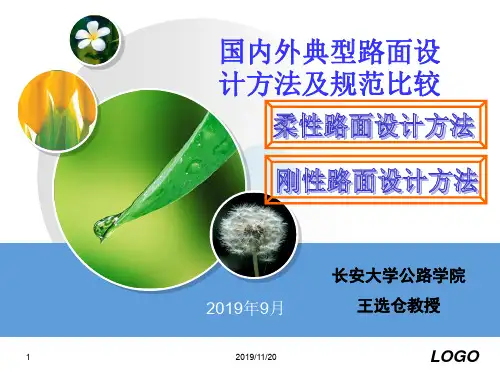

浅探柔性路面的组合设计摘要:柔性路面设计的首要目标,是选择在技术上可靠并能符合经济效益的路面,使其能承受交通荷载和环境因素的作用,在预定的设计年限内处于某一规定的工作状态。
本文结合实际浅探柔性路面设计中路面结构层组合设计,并以沥青路面为例进行分析。
关键词:柔性路面组合设计Abstract: flexible pavement design’s first goal, it is a choice in technology and reliable can accord with the economic benefits of the pavement, make it can withstand the traffic load and the role of environmental factors, in the design of the reservation period in a specified state. Combining with the actual shallow ground flexible pavement design pavement structure layer combination of design, and to the asphalt pavement as an example for analysis.Keywords: flexible pavement design combination1前言柔性路面设计的首要目标,是选择在技术上可靠并能符合经济效益的路面,使其能承受交通荷载和环境因素的作用,在预定的设计年限内处于某一规定的工作状态。
柔性路面设计的内容,包括路面结构层组合设计、路面结构计算以及路面材料配合比设计。
当前世界各国众多的柔性路面设计方法,可概括分为两大类:一类是以经验或以试验为依据的经验法;一类是以力学分析为基础,考虑环境、交通条件以及材料特性等因素的理论法。

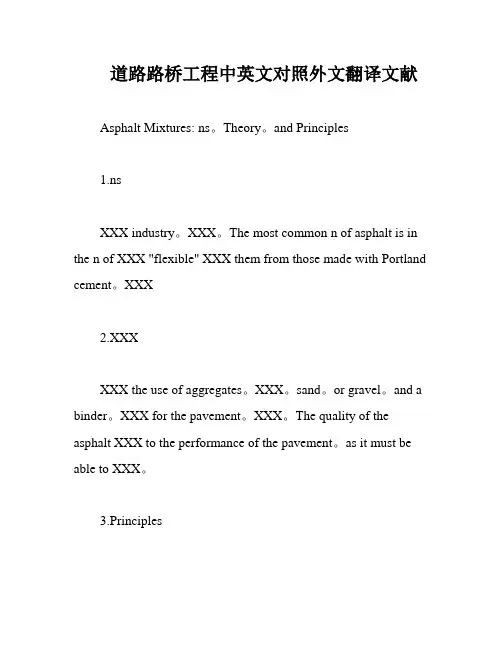
道路路桥工程中英文对照外文翻译文献Asphalt Mixtures: ns。
Theory。
and Principles1.nsXXX industry。
XXX。
The most common n of asphalt is in the n of XXX "flexible" XXX them from those made with Portland cement。
XXX2.XXXXXX the use of aggregates。
XXX。
sand。
or gravel。
and a binder。
XXX for the pavement。
XXX。
The quality of the asphalt XXX to the performance of the pavement。
as it must be able to XXX。
3.PrinciplesXXX。
with each layer XXX layers typically include a subgrade。
a sub-base。
a base course。
and a surface course。
The subgrade is the natural soil or rock upon which the pavement is built。
while the sub-base and base courses provide nal support for the pavement。
The surface course is the layer that comes into direct contact with traffic and is XXX。
In n。
the use of XXX.The n of flexible pavement can be subdivided into high and low types。
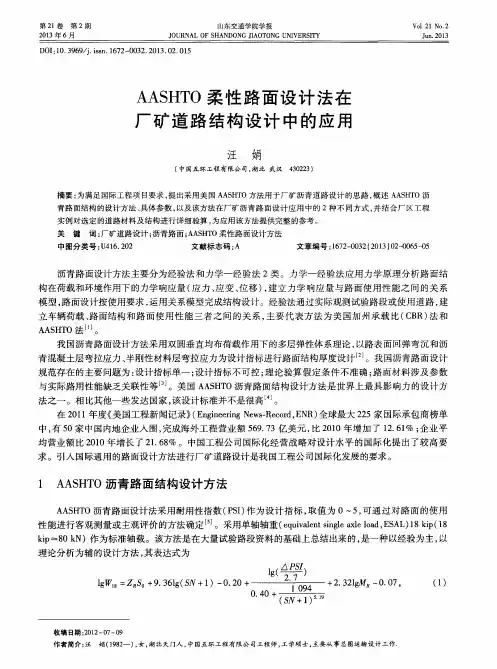
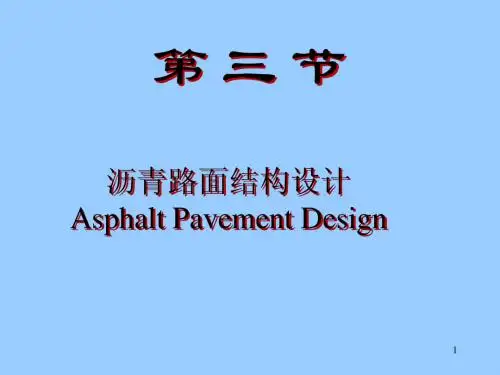
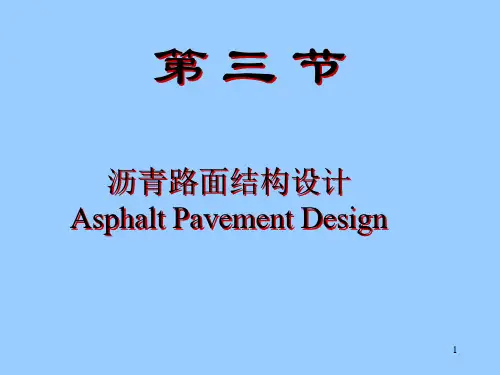
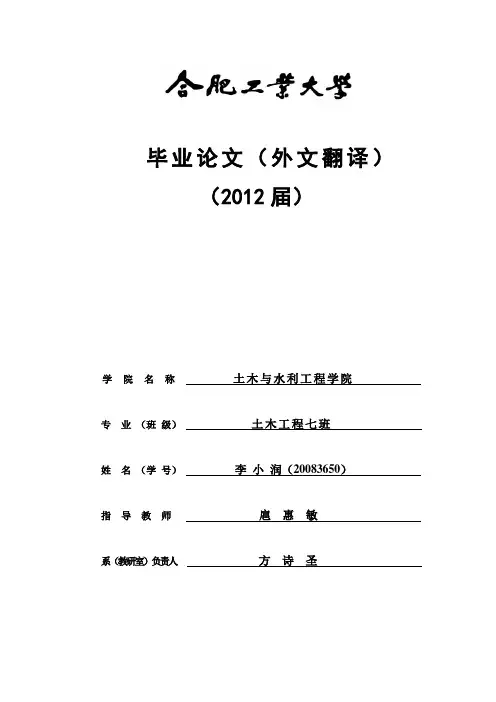
毕业论文(外文翻译)(2012届)学院名称土木与水利工程学院专业(班级)土木工程七班姓名(学号)李小润(20083650)指导教师扈惠敏系(教研室)负责人方诗圣PavementHighway pavements are divided into two main categories: rigitand flexible.The wearing surfaceof a rigid pavement is usually constructed of Portland cement concrete such that it acts like a beam over any irregularities in the underlying supporting material.The wearing surface of flexible pavements, on the other hand, is usually constructed of bituminous material such that they remain in contact with the underlying material even when minor irregularities occur.Flexible pavements usually consist of a bituminous surface underlaid with a layer of granular material and a layer of a suitable mixture of coarse and fine materials.Coarse aggregatesFine aggregatesTraffic loads are transferred by the wearing surface to the underlying supporting materials through the interlocking of aggregates, the frictionaleffect of the granular materials, and the cohesion of the fine materials.Flexible pavements are further divided into three subgroups: high type, intermediate type, and low type. High-type pavements have wearing surfaces that adequately support the expected traffic load without visible distress due to fatigue and are not susceptible to weather conditions.Intermediate-type pavements have wearing surfaces that range from surface treated to those with qualities just below that of high-type pavements. Low-type pavements are used mainly for low-cost roads and have wearing surfaces that range from untreated to loose natural materials to surface-treated earth.✹The components of a flexible pavement include the subgradeor prepared roadbed, the subbase, basecourse, and the surface course (Fig.11.1).✹Upper surface courseMiddle surface courseLower surface courseThe performance of the pavement depends on the satisfactory performance of each component, which requires proper evaluation of the properties of each component separately.✹The subgrade is usually the natural material located along the horizontal alignment of the pavement and serves as the foundation of the pavement structure.✹The subgrademay also consist of a layer of selected borrow materials, well compacted to prescribedspecifications.✹Compacting plantCompaction deviceCompactnessIt may be necessary to treat the subgrade material to achieve certain strength properties required for the type of pavement being constructed.Located immediately above the subgrade, the subbase component consists of a superior quality to that which generally is used for subgrade construction. The requirements for subbase materials are usually given in terms of the gradation, plastic characteristics, and strength. When the quality of the subgrade material meets the requirements of the subbase material, the subbase component may be omitted.In cases where suitable subbase material is not readily available ,the available material can be treated with other materials to achieve the necessary properties. This process of treating soils to improve their engineering properties is know as stabilization.✹The base course lies immediately above the subbase. It is placed immediately above the subgrade if a subbase course is not used.✹This course usually consists of granular materials such as crushed stone, crushed or uncrushed.The specifications for base course materials usually include stricter requirements than those for subbase materials, particularly with respect to their plasticity, gradation, and strength.Materials that do not have the required properties can be used as base materials if they are properly stabilized with Portland cement, asphalt, or lime .In some cases, high-quality base course materials may also be treated with asphalt or Portland cement to improve the stiffness characteristics of heavy-duty pavementsThe surface course is the upper course of the road pavement and is constructed immediately above the base course. The surface course in flexible pavement usually consists of a mixture of mineral aggregates and asphaltic materials.It should be capable of withstanding high tire pressures, resisting the abrasive forces due to traffic, providing a skid-resistant driving surface, and preventing the penetration of surface water into the underlying layers.✹The thickness of the wearing surface can vary from 3 in. to more than 6 in.(inch,英寸,2.54cm), depending on the expected traffic on the pavement.It was shown that the quality of the surface course of a flexible pavement depends on the mix design of the asphalt concrete used.✹Rigid highway pavements usually are constructed to carry heavy traffic loads, although they have been used for residential and local roads. Properly designed and constructed rigid pavements have long service lives and usually are less expensive to maintain than the flexible pavements.✹The Portland cement concrete commonly used for rigid pavements consists of Portland cement, coarse aggregate, fine aggregate, and water. Steel reinforcing rods may or may not be used, depending on the type of pavement being constructed.Rigid highway pavements be divided into three general type: plain concrete pavements, simply reinforced concrete pavements, and continuously reinforced concrete pavement. The definition of each pavement type is related to the amount of reinforcement used.Plain concrete pavement has no temperature steel or dowels for load transfer.However, steel tie bars are often used to provide a hingeeffect at longitudinal joints and to prevent the opening of these joints. Plain concrete pavements are used mainly on low-volume highways or when cement-stabilized soils are used as subbase.Joints are placed at relatively shorter distances (10 to 20 ft) than with the other types of concrete pavements to reduce the amount of cracking.In some case, the transverse joints of plain concrete pavements are skewed about 4 to 5 ft in plan, such that only one wheel of a vehicle passes through the joint at a time. This helps to provide a smoother ride.Simply reinforced concrete pavements have dowels for the transfer of traffic loads across joints, with these joints spaced at larger distances, ranging from 30 to 100 ft. Temperature steel is used throughout the slab, with the amount dependent on the length of the slab. Tie bars are also commonly used in longitudinal joints.Continuously reinforced concrete pavements have no transverse joints, except construction joints or expansion joints when they are necessary at specific positions, such as at bridges.These pavements have a relatively high percentage of steel, with the minimum usually at 0.6 percent of the cross section of the slab. They also contain tie bars across the longitudinal joints.h/2h/25~10cm填缝料 横向施工缝构造填缝料平缝加拉杆型Bituminous Surface CoursesThe bituminous surface course has to provide resistance to the effects of repeated loading by tyres and to the effects of the environment.✹In addition, it must offer adequate skid resistance in wet weather as well as comfortable vehicle ride. It must also be resistant to rutting and to cracking.✹It is also desirable that surface course is impermeable, except in the case of porous asphalt.Hot rolled asphalt (HRA) is a gapgraded material with less coarse aggregate. In fact it is essentially a bitumen/fine aggregate/filler mortar into which some coarse aggregate is placed.The mechanical propertiesare dominated by those of the mortar. This material has been extensively used as the wearing course on major road in the UK, though its use has recently declined as new materials have been introduced.✹It provides a durablelayer with good resistance to cracking and one which is relatively easy to compact. The coarse aggregate content is low (typically 30%) which results in the compacted mixture having a smooth surface. Accordingly, the skid resistance is inadequate and precoated chippings are rolled into the surface at the time of laying to correct this deficiency.In Scotland, HRA wearing course remains the preferred wearing course on trunk roads including motorway but,since 1999 thin surfacings have been the preferred option in England and Wales. Since 1999 in Northern Ireland, HRA wearing course and thin surfacings are the preferred permitted options.Porous asphalt (PA) is a uniformly graded material which is designed to provide large air voids so that water can drain to the verges within the layer thickness. If the wearing course is to be effective, the basecourse below must be waterproof and the PA must have the ability to retain its open textured properties with time.Thick binder films are required to resist water damage and ageing of the binder. In use, this material minimizes vehicle spray, provides a quiet ride and lower rolling resistance to traffic than dense mixtures.✹It is often specified for environmental reasons but stone mastic asphalt (SMA) and special thin surfacings are generally favoured in current UK practice.There have been high profile instances where a PA wearing course has failed early in its life. The Highways Agency does not recommend the use of a PA at traffic levels above 6000 commercial vehicles per day.✹Asphaltic concrete and dense bitumen macadam (DBM) are continuously graded mixtures similar in principle to the DBMs used in roadbases and basecourses but with smaller maximum particle sizes. Asphaltic concrete tends to have a slightlydenser grading and is used for road surfaces throughout the world with the excepting of the UK.✹It is more difficult to meet UK skid resistance Standards with DBMs than HRA, SMA or PA. This problem can be resolves by providing a separate surface treatment but doing so generally makes DBM economically unattractive.✹Stone mastic asphalt (SMA) material was pioneeredin Germany and Scandinavia and is now widely used in the UK. SMA has a coarse, aggregrate skeleton, like PA, but the voids are filled with a fine aggregate/filler /bitumen mortar.✹In mixtures using penetration grade bitumen , fibres are added to hold the bitumen within the mixture (to prevent “binder drainage”).Bitumen✹oil bitumen( earth oil)✹natural bitumen✹TarWhere a polymer modified bitumen is used, there is generally no need for fibres. SMA is a gap-graded material with good resistance to rutting and high durability. modified bitumen✹SBS✹SBR✹PE\EV A✹It differs from HRA in that the mortar is designed to just fill the voids in the coarse aggregate whereas, in HRA, coarse aggregate is introduced into the mortar and does not provide a continous stone matrix. The higher stone content HRAs ,however, are rather similar to SMA but are not wide used as wearing courses in the UK, being preferred for roadbase and basecourse construction.A variety of thin and what were called ultra thin surfacings (nowadays, the tendency is to use the term ‘thin surfacings’ for both thin and ultra thin surfacings ) have been introduced in recent years, principally as a result of development work concentrated in France.These materials vary in their detailed constituents but usually have an aggregate grading similar to SMA and often incorporate a polymer modified bitumen.They may be used over a high stiffness roadbase and basecourse or used for resurfacing of existing pavements. For heavy duty pavements (i .e those designed to have a useful life of forty years), the maintenance philosophy is one of minimum lane occupancy, which only allows time for replacement of the wearing course to these ‘long life’ pavement structures. The new generation of th in surfacings allows this to be conveniently achieved.The various generic mixture types described above can be compared with respect to their mechanical properties and durability characteristics by reference to Fig.12.1. This shows, in principle, how low stone content HRA, asphaltic concrete, SMA and PA mixtures mobilize resistance to loading by traffic.Asphaltic concrete (Fig.12.1a)) presents something of a compromise when well designed, since the dense aggregate grading can offer good resistance to the shear stresses which cause rutting, while an adequate binder content will provide reasonable resistance to the tensile stresses which cause cracking.In general, the role of the aggregate dominates. DBMs tend to have less dense gradings and properties which, therefore, tend towards good rutting resistance andaway from good crack resistance.HRA (Fig.12.1b)) offers particularly good resistance to cracking through the binder rich mortar between the coarse aggregate particles. This also provides good durability but the lack of coarse aggregate content inhibits resistance to rutting.SMA and PA are shown in the same diagram ( Fig.c)) to emphasis the dominant role the coarse aggregate. In both case, well coated stone is used. In PA, the void space remains available for drainage of water, whilst in SMA, the space is occupied by a fine aggregate/ filler/ bitumen/ fibre mortar.Both materials offer good rutting resistance through the coarse aggregate content. The tensile strength of PA is low whilst that of SMA is probably adequate but little mechanical testing data have been reported to date.Drainage for Road and Airports✹Provision of adequate drainage is important factor in the location and geometric design of road and airports. Drainage facilities on any highway, street and airport should adequately provide for the flow of water away from the surface of the pavement to properly designed channels.Inadequate drainage will eventually result in serious damage to the structure.✹In addition, traffic may be slowed by accumulated water on the pavement, and accidents may occur as a result of hydroplaning and loss of visibility from splash and spray. The importance of adequate drainage is recognized in the amount of highway construction dollars allocated to drainage facilities. About25 percent of highway construction dollars are spent for erosion control anddrainage structures, such as culverts, bridges, channels, and ditches.✹Highway Drainage Structures✹One of the main concerns of the highway engineer is to provide an adequate size structure, such that the waterway opening is sufficiently large to discharge the expected flow of water.Inadequately sized structures can result in water impounding, which may lead to failure of the adjacent sections of the highway due to embankments being submerged in water for long periods.✹The two general categories of drainage structures are major and minor. Major structures are those with clear spans greater than 20 feet, whereas minor structures are those with clear spans of 20 feet or less .✹Major structures are usually large bridges, although multiple-span culverts may also be included in this class. Minor structures include small bridges and culverts.Emphasis is placed on selecting the span and vertical clearancerequirements for major structures. The bridge deck should be located above the high water mark .The clearance above the high water mark depends on whether the waterway is navigable ✹If the waterway is navigable, the clearance above the high water mark should allow the largest ship using the channel to pass underneath the bridge without colliding with the bridge deck. The clearance height, type, and spacing of piers also depend on the probability of ice jams and the extentto which floating logs and debris appear on the waterway during high water.✹An examination of the banks on either side of the waterway will indicate the location of the high water mark, since this is usually associated with signs of erosion and debris deposits. Local residents, who have lived near and observed the waterway during flood stages over a number of years, can also give reliable information on the location of the high water mark. Stream gauges that have been installed in the waterway for many years can also provide data that can be used to locate the high water mark.Minor structures, consisting of short-span bridges and culverts, are the predominant type of drainage structures on highways. Although openings for these structures are not designed to be adequate for the worst flood conditions, they shouldbe large enough to accommodate the flow conditions that might occur during the normal life expectancy of the structure.✹Provision should also be made for preventing clogging of the structure due to floating debris and large boulders rolling from the banks of steep channels.✹Culverts are made of different materials and in different shapes. Materials used to construct culverts include concrete(reinforced and unreinforced), corrugated steel, and corrugatedaluminum. Other materials may also be used to line the interiorof the culvert to prevent corrosion and abrasionor to reduce hydraulic resistance. For example, asphaltic concrete may be used to line corrugated metal culverts. The different shapes normally used in culvert construction include circular, rectangular (box), elliptical, pipe arch, metal box, and arch.✹The drainage problem is increased in these areas primarily for two reasons: the impervious nature of the area creates a very high runoff; and there is little room for natural water courses. It is often necessary to collect the entire storm water into a system of pipes and transmit it over considerable distances before it can be loosed again as surface runoff. This collection and transmission further increase the problem, since all of the water must be collected with virtually no pending, thus eliminating any natural storage; and through increased velocity the peak runoffs are reached more quickly.Also, the shorter times of peaks cause the system to be more sensitive to short-duration,high intensive rainfall.Storm sewers,like culverts and bridges,are designed for storms of various intensity-return-period relationships, depending upon the economy and amount of ponding that can be tolerated.✹Airport Drainage✹The problem of providing proper drainage facilities for airports is similar in many ways to that of highways and streets. However, because of the large and relatively flat surface involved, the varying soil conditions, the absence of natural water courses and possible side ditches, and the greater concentration of discharge at the terminus of the construction area, some phases of the problem are more complex. For the average airport the over-all area to be drained is relatively large and an extensive drainage system is required. The magnitude of such a system makes it even more imperative that sound engineering principles based on all of the best available data be used to ensure the most economical design.Overdesigning of facilities results in excessive money investment with no return, and underdesigning can result in conditions hazardous to the air traffic using the airport. In order to ensure surfaces that are smooth, firm, stable, and reasonably free from flooding, it is necessary to provide a system which will do several things.It must collect and remove the surface water from the airport surfaces; intercept and remove surface water flowing toward the airport from adjacent areas; collect and remove any excessive subsurface water beneath the surface of the airport facilities and in many cases lower the ground-water table; and provide protection against erosion of the sloping areas.路面公路的路面被分为两类:刚性的和柔性的。
黑龙江交通科技HEILONGJIANG JIAOTONG KEJI2020年第4期(总第814期)No. 4,2020(Sum No. 814)柔性路面设计方法宋杨(黑龙江省公路勘察设计院,黑龙江哈尔滨150080)摘要:从几个方面介绍了柔性路面的设计方法。
关键词:中国规范;美国规范;比较;性能方程;弹性层状连续体系中图分类号:U419 文献标识码:A 文章编号:1008 -3383(2020)04 -0073 -011 AASHT 0路面结构设计方法牙买加当地采用《AASHTO 路面结构设计1993 版》中的柔性路面设计方法,设计方法如下:(1)性能方程中各参数存在对应关系,为迭代 方程,需要不断试算SN,Z r 和S 0以满足要求。
log /肌3 =Z R x S o +9. 36 xlogi0(SN + 1)-(1)o r Ap shloglo[ 1 294J262+5O 1 294 +O22 + (SN + 1)5652.32 xlog 9M R -8.25其中,比9—营运期交通量;Z r —为给定可靠性 的正态偏移;一可靠性;S 0—全局标准差;M r —有 效的路床顶材料回弹模量MPS/—路面服务能力指数;S N —路面的设计结构序列。
公式中涉及到的几个参数的意义分别为① ^/预测交通®% =D ” xD i xW/ (2)其中,D d —方向系数;2—车道系数;W9 —设 计基准期下每类车辆双向交通量根据车辆换算系数换算成18-kn 标准轴载。
② R 可靠性可靠性是考虑设计中各种确定性的参数,可以根据道路等级查询。
③ S 全局标准差根据正态分布的统计学原理,性能方程中所有 性能参数均为均值2卩设计可靠度为50%的值。
为 了得到较高的指定的可靠度,则W /必须小于W 1 一个正态偏移Z r 。
即,z log%-log W9 小、Z r =-----S ---------- (8)④M r 有效的路床顶材料回弹模量,即中国规中路基回弹模路基回弹模量可以通过试验确定,如不具备试验条件,可以通过标准CBR 值,R-value ,以及土的各种指数估计。
AASHTO柔性路面设计方案美国各州公路及运输工作者协会(AASHTO)所推荐的方法是以50年代后期和60年代初在渥太华、伊利诺伊州进行的AASHTO道路试验得到的大量试验成果为基础的。
AASHTO设计委员会于1961年第一次出版了暂行设计指南,1972和1981年又作了修订。
1984~1985年,路面设计委员会和顾问小组根据NCHRP项目20-7/24的研究情况对指南作了修订和扩大,并于1986年出版了现行指南。
AASHTO道路试验所得到的经验性能方程,在现行的指南中仍用作为基本模型,但是作了修正和扩大,使其能适用于美国其他地区。
应注意,初始方程是在给定的气候条件下,针对某种特定的路面材料和地基土推导出来的。
试验地点气候温和,年降水量约为864mm(34in)。
平均冰冻深度约为711mm(28in)。
地基土属于A-6和A-7,排水条件不良,CBR值为2~4。
一、设计变量本节介绍一些与柔性路面和刚性路面都有关的一般设计变量。
其他变量如有效路基土回弹模量和结构数将分别在11.3.3和11.3.4中介绍。
(一)时间约束为了充分利用可能获得的资金,AASHTO设计指南鼓励对交通量大的工程采用较长的分析年限,至少包括一次大修期。
因而,分析年限应等于或大于工作年限,如下所述。
1、工作年限工作年限是指初建的路面结构至需要大修以前的时间,或者是两次大修之间的时间。
它相当于新建的、重建的或经过大修的结构,由其初始服务能力,损坏至最终服务能力所经过的时间。
设计者必须在部门的经验和政策所规定的最小和最大允许围选定工作年限。
工作年限的选定受如下因素的影响:路面的功能等级,维护的类型和水平,用于初期修建的资金,寿命周期费用和其它工程上的考虑。
2、分析年限分析年限为任何设计策略所必须包括的时段。
它可以和选用的工作年限相同。
然而,由于实际工作制约,对所需的分析年限,可能要考虑分期修建或者计划大修。
过去,路面常按20年工作年限进行设计和分析。
AASHTO法美国各州公路及运输工作者协会(AASHTO)所推荐的方法是以50年代后期和60年代初在渥太华、伊利诺伊州进行的AASHTO道路试验得到的大量试验成果为基础的。
AASHTO设计委员会于1961年第一次出版了暂行设计指南,1972和1981年又作了修订。
1984~1985年,路面设计委员会和顾问小组根据NCHRP项目20-7/24的研究情况对指南作了修订和扩大,并于1986年出版了现行指南。
AASHTO道路试验所得到的经验性能方程,在现行的指南中仍用作为基本模型,但是作了修正和扩大,使其能适用于美国其他地区。
应注意,初始方程是在给定的气候条件下,针对某种特定的路面材料和地基土推导出来的。
试验地点气候温和,年降水量约为864mm(34in)。
平均冰冻深度约为711mm(28in)。
地基土属于A-6和A-7,排水条件不良,CBR值为2~4。
一、设计变量本节介绍一些与柔性路面和刚性路面都有关的一般设计变量。
其他变量如有效路基土回弹模量和结构数将分别在11.3.3和11.3.4中介绍。
(一)时间约束为了充分利用可能获得的资金,AASHTO设计指南鼓励对交通量大的工程采用较长的分析年限,至少包括一次大修期。
因而,分析年限应等于或大于工作年限,如下所述。
1、工作年限工作年限是指初建的路面结构至需要大修以前的时间,或者是两次大修之间的时间。
它相当于新建的、重建的或经过大修的结构,由其初始服务能力,损坏至最终服务能力所经过的时间。
设计者必须在部门的经验和政策所规定的最小和最大允许范围内选定工作年限。
工作年限的选定受如下因素的影响:路面的功能等级,维护的类型和水平,用于初期修建的资金,寿命周期费用和其它工程上的考虑。
2、分析年限分析年限为任何设计策略所必须包括的时段。
它可以和选用的工作年限相同。
然而,由于实际工作制约,对所需的分析年限,可能要考虑分期修建或者计划大修。
过去,路面常按20年工作年限进行设计和分析。
柔性路面结构设计--long柔性路面结构设计设计路段为二级沥青路面,设计年限8年,交通量平均年增长率为8%,混合交通,预计设计初期的日交通量如下表2-1。
表中2-1设计初期的日交通量路段为广东ⅳ区,粘性土,地下水位离地面1.4m,填土高0.4m。
3.设计内容根据交通部《公路沥青路面设计规范》jtj014-97,展开下列内容的研究:(1)用两种结构比较,确认路面结构层女团(2)进行路面结构层厚度的设计和抗弯拉强度验算(3)路面横断面设计(4)路面结构层的施工质量掌控标准(5)工程量排序路面设计以双轮组单轴载100kn为标准轴载。
(1)以设计弯沉值指标及求函数沥青层层底拉形变中的总计当量轴次轴载换算采用如下的计算公式n=∑c1c2ni(i)4.35计算结果如表2-2所示表中2-2轴有载折算结果(弯沉)注:轴载小于25kn的轴载作用不计。
②总计当量轴次根据已知资料,沥青路面的设计年限为8年,双车道无分隔带的车道系数是0.6-0.7,η取0.67。
[(1+γ)-1]⨯365nη=[(1+0.08)-1]⨯365⨯269⨯0.67=699719(次)=(2)验算半刚性基层层底拉应力中的累计当量轴次求函数半刚性基层层底扎形变的轴有载折算公式:n'=∑c'1c'2ni(结果如表2-3所列。
表中2-3轴有载折算结果(半刚性基层层底扎形变)注:轴载小于50kn的轴载作用不计。
②总计当量轴次参数取值同上,设计年限是8年,车道系数取0.67。
累计当量轴次为:[(1+γ)-1]⨯365nη=[(1+0.08)-1]⨯365⨯240.6⨯0.67=625846(次)n'=2.结构组合与材料选取由上面的排序获得设计年限内一个行车道上的总计标准轴次约为70万次左右。
现挑选出两种结构展开比较,根据规范所推荐结构,第一种路面结构面层使用沥青混凝土(挑6cm),基层使用石灰土碎石(挑20cm),底基层使用石灰土(厚度特定);第二种路面结构面层使用沥青混凝土(挑6cm),基层使用水泥石灰沙砾土(挑20cm),底基层使用石灰土(厚度特定)。
附录1:外文文献翻译对柔性路面面层开裂的三维有限元分析Hasan Ozer, Imad L. Al-Qadi* and Carlos A. Duarte美国伊利诺伊大学厄本那—香槟分校,土木与环境工程系, IL 61801摘要:靠近路面表层的开裂是导致道路寿命缩短的主要因素之一。
重交通荷载、施工缺陷、表层混合料的特征是导致路面表层开裂的主要原因。
此外,形状不规则的轮胎与路面的接触力有可能在路面表层附近产生极其复杂的应力状态。
在这种条件下预测裂纹扩展需要对多种路面结构状态如应力、应变、位移做高精度计算。
广义有限元方法(GFEM)提供了一个计算框架,当使用一个扩展的策略时,裂缝在有限单元网格中可能沿任意方向发展。
此扩展方法在GFEM中也能提高多项式近似计算的精度。
使用GFEM时会对地表层裂缝执行三维分析,建立持久路面结构的大型三维模型,在不同位置插入裂缝。
拥有集料规模缺陷的持久路面结构的数值试验揭示了双轮胎下路面断裂的复杂情形。
关键词:由上而下产生裂缝(top-down crack);广义有限元法;混合模型;持久路面;1. 简介靠近上面层的裂缝,即自上而下开展的裂缝(top-down cracking,以下简称“上贯缝”),一直被认为是柔性路面的主要损坏形式之一。
随着长效路面,即人们所认为的持久路面建设率的增加,这种损坏现象也随之增加。
这些路面常为了增加寿命而有较厚的沥青混合料层。
在这种情况下,裂缝只限于表面。
然而,人们还没有弄明白靠近路面表层的结构层。
研究“上贯缝”的学者在没有识别裂缝产生的位置的情况下,就导致开裂的原因达成共识。
不规则的轮胎接触压力、横向组件与温度荷载时主要因素。
由于粘结剂的老化和分离,刚度梯度的变化成了另一个增加裂缝发展的因素。
许多学者通过现场调查研究了这一复杂的现象。
利用多种数值方法分析、实验室模拟和大规模的测试,De freitas et al.在2005年识别出了几个导致上贯缝产生的原因,开始利用实验室、三维有限元法(FE)评估了其中的一些原因。
英文翻译Flexible pavement designGenerally speaking,pavements(and bases) may be divided into two broad classifications or tipes:rigid and flexible. As commonly used in the United States,the term “rigid pavement”is applied to wearing surfaces constructed of Portland-cement concrete. A pavement constructed of concrete is assumed to possess considerable flexural strength that will permit it to act as a beam and allow it to bridge over minor irregularities which may occor in the base or subgrade on which it rests;hence the term “rigid”.Similarity,a concrete base that supports a brick or block layer might be described as “rigid”.All other types of pavement have traditionally been classed as “flexible”.A commonly used definition is that “a flexible pavement is a structure that maintains contact with and distributes loads to the subgrade and depends on aggregate interlock,particlefriction,and cohesion for stability”.Thus,the classical flexible pavement include primarily those pavement that are composed of a series of granular layers topped by a relatively thin high-quality bituminous wearing surface .Typically,the highest-quatily materials are at or near the surface.It should be pointed out that certain pavementsthat have an asphalt surface may behave more like the classical “rigid”pavement,for example, pavement that have very thick asphalt surface or that have base courses composed of aggregate treated with asphalt,cement, or lime-fly ash. However,for convenience of presentation,these pavements will be considered to be in the flexible class.The structure of flexible pavement is composed of a “wearing surface”, base, subbase(not always used), and subgrade . The wearing surface and the base often comprise two or more layers that are somewhat different in composition and that are put down in separate construction operations.On many heavy-duty pavements,asubbase of select material is often placed between the base and subgrade.the wearing surface may range in thickness from less than 1 in. in the case of a bituminous surface used for low-cost, light-traffic loads to 6 in. or more of alphaltconcrete used for heavily traveled routes. The wearing surface must be capable of withstanding the wear and abrasive effects of moving vehicles and must possess sufficient stability to prevent it from shoving and rutting under traffic loads. In addition,it serves a useful purpose in preventing the entrance of excessive quantities of surface water into the base subgrade from directly above.The base is a layer (or layers) of very high stability and density. Its principle purpose is to distribute or “spread” the stresses created by wheel loads acting on the wearing surface so that the stresses transmitted to the subgrade will not be sufficiently great to result in excessive deformation or displacement of that foundation layer. The base must also be of such character that it is not damaged by capillary water and/or frost action. Locally available materials are extensively used for base construction, and materials preferred for this type of construction vary wwidely in different sections of the country. For example, the base may be composed of gravel or crushed rock or it may bae a granular material treated with asphalt,cement,or lime-fly ash stabilizing agents.Asubbase of granular material or stabilized material may be used in areas where frost action is severe, in locations where the subgrade soil is extremely weak. It may also be used , in the interests of economy ,in locations where suitable subbase material are cheap than base materials of higher quality.The subgrade is the foundation layer, the structure that must eventually support all the loads which come onto the pavement. In some cases this layer will simply be the natural earth surface. In other or more usual instances it will be compacted soil existing in a cut section or the upper layer of an embankment section. In the fundamental concept of the action of flexible pavement,the combined thickness of subbase (if used), base, and wearing surface must be great enough to reduce the stresses occuring in the subgrade to values that are not sufficiently great to cause excessive distortion or displacement of the subgrade soil layer.The principle factors entering into the problem of the thickness design of flexible pavement are:(1)Traffic loading.(2)Climate or environment.(3)Material characteristics.A number of other elements must also be considered in order to arrive at a final thickness design. This include cost, construction, maintenance,an design period. Thus, the students should realize that the design process is complex, and it is highly unlikely that any extremely simple method of approach will prove entirely successful under all conditions.Protection of the subgrade from the loading imposed by traffic is one of the primariy functions of a pavement structure. The designer must privide a pavement that can withstand a large number of repeated applications of variable-magnitude loading.The magnitude of maximum loading is commonly controlled by legal load limits. Traffic surveys and loadometer studies are often used to establish the relative magnitude and occurrence of the various loading to which a pavement is subjected. Prediction or estimation of the total traffic that will use a pavement during its design ife is a very difficult but obviously important task.The climate or environment in which a flexible pavement is to be established has an important influence on the behavior and performance of the various in the pavement and subgrade. Probablly the two climate factors of major significance are temperature and moisture.The magnitude of temperature and its fluctuations affect the properties of certain materials. For example, high temperatures cause asphaltic concrete to lose stability whereas at low temperatures asphaltic concrete becomes very hard and stiff. Low temperature and temperature fluctuations are also associated with frost heave and freeze-thaw damage.Granular materials, if not properly graded, can experience frost heave. Likewise, the subgrade can exhibit extensive loss in strength if it becomes frozen. Certain stabilized materials (lime, cement, and lime-fly ash treated) can suffer substantial damage if a large number of freeze-thaw cycles occur in the material.Moisture also has an important influence on the behavior and performance ofmany materials. Moisture is an important ingredient in frost-related damage. Subgrade soils and other paving materials weaken appreciably when saturated, and certain clayey soil exhibit substantial moisture-included volume change.Subgrade moisture conditions change is affecting road structural strength, stiffness and stability of the important factors. Subgrade moisture influence has the following main factors: atmospheric precipitation and evaporation, infiltration of surface water, groundwater impact, temperature changes caused by humidity. Cyclical atmospheric temperature changes throughout the year, day and night temperatures for each day a certain extent cyclical changes. Surface directly exposed to the air, and experiencing the impact of these changes, in particular surface material most affected. Road surface temperature change with the weather temperature is roughly synchronized. Surface layer temperature at different depths within the same generation as the cyclical changes in atmospheric temperature, but the magnitude of change increases with the depth gradually decreased.One of frost damage is frozen, it not only affects the normal running of vehicles, and sometimes the destruction of the pavement structure. Produce frost heave for two reasons: First, as water is frozen, the volume will increase by 9%; second is due to the weak foundation soil to freeze the area with water movement results. Subgrade frost heaving caused by three factors: the sensitivity of frozen soil subgrade; temperature decreased slowly; groundwater supply of water to keep the frozen zone.The advent of spring, began to melt the frozen roadbed, will lose their bearing capacity of soil, leading to road damage, a phenomenon known as the spring melt boil, boil and mainly due to the melting process is top down, when the embankment top soil begins to melt, the water can not be excluded, so the soil has been saturated melting. If by this time a large number of heavy vehicles, road structure would be seriously damaged.Of the road is a sticky, elastic-plastic materials and the combination of mineral aggregate particles consisting of roads, including the addition of cement concrete as a surface layer and the surface structure of a variety of other grass-roots level. Flexible pavement design including pavement layer combination of design, structuralcalculation and the road pavement material mix design. This chapter elaborates the following aspects: elastic layered system theory, the pavement layer combination of design principles, road design standards and parameters, calculation of pavement thickness and the bending stress check.In reality, the road base material and the soil is not in any case have elastic properties. Non-linear elastic - viscous - plastic theory, under certain conditions more accurately describe the stress state of the road, but taking into account the role of the transient driving wheels in the pavement structure, the stress was small, so you can road as each layer is an ideal elastic body, multi-layer linear elastic theory to application to design calculations. Multi-layer linear elastic theory must be used the following basic assumptions:yers of material are continuous, homogeneous, isotropic and to obey Hooke's law, and the displacement and deformation is small;2. The next level (soil basis) in the horizontal direction and vertical direction down to infinity, The elastic layer is above all have a certain thickness, but the horizontal direction is infinite;3. layers of infinite distance in the horizontal direction and the next layer down to infinite depths, the stress, strain and displacement is zero;4. layers the contact conditions between fully continuous;5. do not count weight.Flexible Pavement Structure Design's mission is to design principles in general under the guidance of the road, according to the road level, requirements and design life of the cumulative equivalent standard axle load axle, considering the supply of road materials, the degree of influence of natural factors and the specific construction conditions, determine a reasonable level of the pavement structure and select the appropriate economic composition materials, combined into both withstand traffic loads and the role of natural factors, but also give full play to the maximum performance of structural materials, subgrade layer pavement system. Combination of flexible pavement structural design should follow the following basic principles:1, route, embankment, road do take into consideration the overall design;2, according to the structure, function and transport layer characteristics of selected structural levels;3, the strength to adapt to traffic load and stiffness combination;4, pay attention to its own characteristics each layer, make layer combination;5, the appropriate number of layers and thickness;6, to consider the impact of water temperature conditions to ensure stability.柔性路面设计一般来讲,路面(和路基)可以分为两种类型:刚性路面和柔性路面。